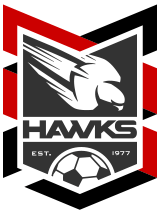
Sports Injury Prevention and Treatment
January 31, 2022
Holland Park Hawks FC First Aid
Whites Hill Reserve – Green Equipment Shed
Ice, Instant Ice-Packs, First Aid Kit, Defibrillator
Whites Hill College – Equipment Shed
Instant Ice-Packs, First Aid Kit, Defibrillator (coming Feb 2022)
Team Coaches
Team Coaches have access to first aid and instant ice-packs in the equipment shed, as required.
Physio
We have a physiotherapist in attendance for all FQPL matches and at selected FQPL training sessions and a sports trainer in attendance during all NPL Youth games. Team Coaches have access to the emergency yellow access gate to Whites Hill Reserve. Ambulance access for Whites Hill College is via Abbott Street.
Out of Hours – Please call 000. Even if it ‘seems silly’, in the event of an injury (especially a head injury) it is better to be safe than sorry.
Triage is available at Holland Park General Practice, 1173 Logan Road, Holland Park and is available Saturdays and Sundays (limited times).
Our nearest private hospital is Greenslopes and our nearest public hospital is the Mater Hospital in Southbank.
Sports Injuries
Sports injuries are commonly caused by overuse, direct impact, or the application of force that is greater than the body part can structurally withstand. There are two kinds of sports injuries: acute and chronic. An injury that occurs suddenly, such as a sprained ankle caused by an awkward landing, is known as an acute injury.
Chronic injuries are caused by repeated overuse of muscle groups or joints. Poor technique and structural abnormalities can also contribute to the development of chronic injuries. Medical investigation of any sports injury is important, because you may be hurt more severely than you think. For example, what seems like an ankle sprain may actually be a bone fracture.
Types of sports injuries
Some of the more common sports injuries include:
- Ankle sprain – symptoms include pain, swelling and stiffness.
- Bruises – a blow can cause small bleeds into the skin.
- Concussion – mild reversible brain injury from a blow to the head, which may be associated with loss of consciousness. Symptoms include headache, dizziness and short term memory loss.
- Cuts and abrasions – are usually caused by falls. The knees and hands are particularly prone.
- Dehydration – losing too much fluid can lead to heat exhaustion and heat stroke.
- Dental damage – a blow to the jaw can crack, break or dislodge teeth.
- Groin strain – symptoms include pain and swelling.
- Hamstring strain – symptoms include pain, swelling and bruising.
- Knee joint injuries – symptoms include pain, swelling and stiffness. The ligaments, tendons or cartilage can be affected.
- Nose injuries – either blood nose or broken nose, are caused by a direct blow.
- Stress fractures – particularly in the lower limbs. The impact of repeated jumping or running on hard surfaces can eventually stress and crack bone.
First aid for sprains, strains and joint injuries
Suggestions on immediate treatment for sprains, strains and joint injuries, to prevent further damage include:
- Rest – keep the injured area supported and avoid using for 48-72 hours.
- Ice – apply ice to the injured area for 20 minutes every two hours for the first 48-72 hours.
- Compression – apply a firm elastic bandage over the area, extending above and below the painful site.
- Elevation – raise the injured area above the level of the heart at all times.
- Referral – as soon as possible, see a doctor.
- No Heat – heat will increase bleeding.
- No Alcohol – alcohol increases bleeding and swelling.
- No Running – running or exercise increases blood flow, delaying healing.
- No Massage – massage increases swelling and bleeding, also delaying healing.
First aid for nose bleeds
Suggestions include:
- Stop the activity.
- Sit with your head leaning forward.
- Pinch your nostrils together and breathe through your mouth.
- Hold your nose for at least 10 minutes.
- If bleeding continues past 30 minutes, seek medical advice.
First aid for dislodged teeth
It may be possible to save a tooth that has been knocked out with prompt dental treatment. Rinse the tooth in water or milk, and see your dentist immediately.
Emergency situations – DIAL 000
Call an ambulance for:
-
prolonged loss of consciousness
-
neck or spine injuries
-
broken bones
-
injuries to the head or face
-
eye injuries
-
abdominal injuries.
Treatment for sports injuries
Treatment depends on the type and severity of the injury. Always see your doctor if pain persists after a couple of days. What you may think is a straightforward sprain may actually be a fractured bone.
Physiotherapy can help to rehabilitate the injured site and, depending on the injury, may include exercises to promote strength and flexibility. Returning to sport after injury depends on your doctor’s or physiotherapist’s assessment.
Trying to play before the injury is properly healed will only cause further damage and delay recovery. The biggest single risk factor for soft tissue injury is a previous injury. While the injury heals, you can maintain your fitness by choosing forms of exercise that don’t involve that part of your body, if possible.
Prevention of sports injuries
You can reduce your risk of sports injuries if you:
- Warm up thoroughly by gently going through the motions of your sport and performing slow, sustained stretches.
- Wear appropriate footwear.
- Tape or strap vulnerable joints, if necessary.
- Use the appropriate safety equipment, such as mouth guards, helmets and pads.
- Drink plenty of fluids before, during and after the game.
- Try to avoid exercising in the hottest part of the day, between 11 am and 3 pm.
- Maintain a good level of overall fitness, particularly in the off season (in the months between playing seasons for a sport).
- Cross-train with other sports to ensure overall fitness and muscle strength.
- Ensure training includes appropriate speed and impact work so muscles are capable of the demands of a game situation.
- Don’t exert yourself beyond your level of fitness. Gradually increase intensity and duration of training.
- Use good form and technique.
- Cool down after sport with gentle, sustained stretches.
- Allow adequate recovery time between sessions.
- Have regular medical check-ups.
Where to get help
- Your doctor
- triage is available Mon- Sun at Holland Park General Practice, 1173 Logan Road, Holland Park
- Sports medicine clinic
- Physiotherapist
- Hospital emergency department
- In an emergency, always call 000 for an ambulance
Things to remember
- Sports injuries are commonly caused by overuse, direct impact, or the application of force that is greater than the body part can structurally withstand.
- Common injuries include bruises, sprains, strains, joint injuries and nose bleeds.
- It is important to see a doctor, as leaving an injury untreated can have far more severe
Injury Management Process
Team officials (coaches, managers or sports trainers) need to follow the procedures below for recording and treatment of players suffering serious injury:
A serious injury is one that prevents a player from participating or completing training and/or games
- any serious injury sustained by a player must be recorded by a team official
- all injuries to be recorded on an Injury Report Form – Football Injury Reporting
- complete the form in as much detail as possible
- Injury Report Forms as to be made available to a club recommended physiotherapist for a referral or to the players preferred physiotherapist
- triage will be established for players on Tuesday night training sessions so that players can have injuries assessed and treatment programs prescribed as preferred
- players suffering from a serious injury cannot return to training or participate in games until full clearance (in writing) has been granted by the physiotherapist
- coaches of injured players must make themselves aware of the progress of the players’ treatment and must receive a clearance to train or play before permitting a player to return to active service












